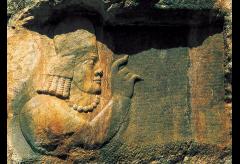The first exhibition of its kind studying the history of Zoroastrianism, its rich cultural heritage and influence on the major world religions of Judaism, Christianity and Islam.
One of the world's oldest religions, Zoroastrianism originated amongst tribes in Central Asia and spread to Iran where it became the principal faith until the advent of Islam. Central to the religion is the belief in a sole creator god, and his emissary Zarathustra (Zoroaster). The Zoroastrian worldview includes the centrality of the opposition of good and evil; the belief that the world is a theatre of war in which these two forces fight one another; the existence of heaven and hell after death; and the belief that the world will come to an end once Evil has been fully overcome.
Artefacts, texts and paintings from major institutions around the world make up a fascinating and diverse collection of over 300 objects that take visitors on a journey from the earliest days of Zoroastrianism to its emergence as the foremost religion of the empires of imperial Iran.
Ten stories within the exhibition explore the ways in which Zoroastrianism has been imagined through the art, iconography and literature of non-Zoroastrians down the ages. Artefacts introduce the imperial periods of Iranian Zoroastrian history.
Illustrated texts and manuscripts written in Avestan, Pahlavi, Persian and Gujarati languages show how the oral tradition was committed to writing during the later periods. An illustrated manuscript of the Arda Viraz Namag - a text from 9th century Iran describes the journey taken by the righteous Viraz through heaven and hell - is all the more remarkable in its connection with visions of heaven and hell when displayed alongside Dante's Divina Commedia and the Islamic Mi'raj Nameh. Miniatures from the Ferdowsi's great Iranian epic the Shahnamah draws on the myths and legends of the pre Islamic period and will be seen for the first time in the context of the Pahlavi books.
From Iran to India the art and artifacts from the eighteenth and nineteenth centuries bear witness to the role of Parsis in the China trade that included opium, silk and tea.
The Everlasting Flame: Zoroastrianism in History and Imagination
The Brunei Gallery, SOAS, Russell Square, London

Ad
Event has ended
This event ended on Saturday 14th of December 2013
This event ended on Saturday 14th of December 2013
Admission
Free
Free
Location
The Brunei Gallery, SOAS, Russell Square, London
Website
Tags:
Art
User Reviews
There are no user reviews
